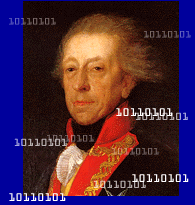| "...after paintings by Velázquez, who would remain, along with Rubens and
Rembrandt, Goya’s greatest source of inspiration." |
Francisco José de Goya y Lucientes was born in the small Spanish town of
Fuendetodos on March 30, 1746. It is located in the Aragonese area of Spain. Goya’s
father was a painter and a gilder of altarpieces, and his mother was descended from a
family of minor nobility. Information about the childhood of Goya's childhood is scarce.
He attended school in Zaragoza at the Escuelas Pias. Goya's formal artistic education
commenced at the age of 14 when he was apprenticed to a local master, José Luzan. Luzan
was a talented painter although little-known outside of his area. Goya spent four years
working in the studio of Luzan.
In 1763 the young artist travelled to Madrid, where he hoped to win a prize
at the Academy of San Fernando. Although he did not win the prize, he did meet Francisco
Bayeu. Bayeu was also from the Aragonese area of Spain and he was working at the court.
Bayeu was very influential in forming Goya's early style. Bayeu also was responsible for
his participation in an important commission, the fresco decoration of the Church of the
Virgin in El Pilar in Zaragoza.
In 1771 Goya travelled to Italy where he remained for approximately one
year. Very little is known of his time there. Goya did spend some months in Rome and
entered a work at the Parma Academy competition, in which he was successful.
Goya returned to Spain about 1773 and participated in several other
fresco projects, including that for the Charterhouse of Aula Dei, near Zaragoza, in 1774.
There paintings prefigure those of his greatest fresco project, which was executed in the
Church of San Antonio de la Florida, Madrid, in 1798. It was during this time that Goya
began to do prints after paintings by Velázquez, who would remain, along with Rubens and
Rembrandt, Goya’s greatest source of inspiration.
By 1786 Goya was working in an official capacity for King Charles III,
certainly the most enlightened Spanish monarch of the 18th century. Goya was appointed
"first court painter" in 1799. His tapestry cartoons executed in the late 1780s
and early 1790s were highly praised for their candid views of everyday Spanish life. Goya
revolutionised the tapestry industry with these cartoons, which had slavishly reproduced
the Flemish genre scenes of the 17th-century painter David Teniers.
Some of Goya's most beautiful portraits date from this period. Many are
of his of his friends, members of the court, and the nobility. Works during this period
also show that Goya was strongly influenced by the English School which was fathered by
Van Dyck.
In the winter of 1792, Goya contracted a serious disease while on a
visit to southern Spain. It left him totally deaf and marked a turning point in his
career. A mood of pessimism entered Goya's work. Between 1797 and 1799 he drew and etched
the first of his great print series The Caprices, which mock the social mores and
superstitions of the time. Later came other series, such as Disasters of War, 1810 and
Absurdities, 1820-1823, which present more caustic commentaries on the ills and follies of
humanity. The horrors of warfare were of great concern to Goya, who observed firsthand the
battles between French soldiers and Spanish citizens during the bloody years of the
Napoleonic occupation of Spain. In 1814 he completed Second of May, 1808 and Third
of May, 1808. These paintings depict horrifying and dramatically brutal massacres of
groups of unarmed Spanish street fighters by French soldiers. Both are painted, like so
many later pictures by Goya, in thick, bold strokes of dark color punctuated by brilliant
yellow and red highlights.
Straightforward candour and honesty are also present in many of Goya's
later portraits, in which the royal family is shown in a completely frank fashion, as a
group of strikingly homely individuals.
Later came the so-called "Black Paintings," scenes of
witchcraft and other bizarre activities. There are among the most outstanding works of the
artist's later years. They were executed about 1820, and most of these paintings are now
in the Prado. Some were originally painted in fresco on the walls of Goya's country house
and later transferred to canvas. These oppressive works attest to his progressively
darkening mood. The oppressive political situation in Spain forced him to depart for
France in 1824. In Bordeaux he took up the then new art of lithography, producing a series
of bullfight scenes, which are considered to be some of the finest lithographs ever made.
Although he returned to Madrid for a brief visit in 1826, he died in self-imposed exile in
Bordeaux two years later, on April 16, 1828. Goya left no immediate followers of
consequence, however there were many artists who copied his style in both France and
Spain. Unfortunately, various experts attributed many of these works to Goya over the last
hundred years.
|

